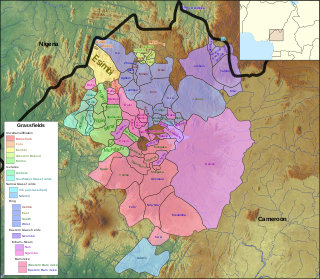Related Research Articles
Wutung (Udung) and Sangke (Nyao) are a Skou language or pair of languages of Papua New Guinea. It is spoken in the villages of Wutung and Sangke in Bewani/Wutung Onei Rural LLG of Sandaun Province. The two varieties are sometimes considered separate languages.
The Yalë language, also known as Yadë, Nagatman, or Nagatiman, is spoken in northwestern Papua New Guinea. It may be related to the Kwomtari languages, but Palmer (2018) classifies it as a language isolate.
Bukawa is an Austronesian language of Papua New Guinea.
Kara is an Austronesian language spoken by about 5,000 people in 1998 in the Kavieng District of New Ireland Province, Papua New Guinea.
May River Iwam, often simply referred to as Iwam, is a language of East Sepik Province, Papua New Guinea.
The Pauwasi languages are a likely family of Papuan languages, mostly in Indonesia. The subfamilies are at best only distantly related. The best described Pauwasi language is Karkar, across the border in Papua New Guinea. They are spoken around the headwaters of the Pauwasi River in the Indonesian-PNG border region.
Telefol is a language spoken by the Telefol people in Papua New Guinea, notable for possessing a base-27 numeral system.
Tifal is an Ok language spoken in Papua New Guinea. Dialects are (1) Tifal (Tifalmin) and Urap (Urapmin) and (2) Atbal (Atbalmin).
Molof is a poorly documented Papuan language spoken by about 200 people in Molof village, Senggi District, Keerom Regency.
Kwomtari is the eponymous language of the Kwomtari family of Papua New Guinea.

Kaure is a Papuan language of West Papua. It is spoken in the villages of Lereh, Harna, Wes, Masta, and Aurina.
One is a Torricelli dialect cluster of West Wapei Rural LLG in Sandaun Province, Papua New Guinea.
Kilmeri, or bo apulyo is a Papuan language of Papua New Guinea near the border with Indonesian Papua. It is not being learned by children.
Angor (Anggor) a.k.a.Senagi is a Senagi language of northern Papua New Guinea. It is spoken in 11 villages of Amanab Rural LLG, Sandaun Province, including Senagi village of Bibriari ward.
Kwoma is a Sepik language of Papua New Guinea also known as Washkuk. The word 'Kwoma' means "hill people". Washkuk is a government name for the people of Kwoma. Linguists have the given the name 'Kwoma' as the primary name of the language, but 'Nukuma' is the specific name for the Northern dialect. Nukuma means people who live along the upper reaches of the Sanchi River. The speakers of Kwoma are located in the Ambunti district of the Sepik River region. There are two dialects known as Kwoma (Washkuk) and Nukuma. The Kwoma dialect or "hill people" is located in the Washkuk Hills which is a range of mountains on the north side of the Sepik. The Nukuma dialect or "headwater people" live to the north and west of the Washkuk range along the Sepik River. Kwoma is considered an endangered language with an estimated 2,925 native speakers worldwide.

The Babanki, or Kejom, language is a Bantoid language that is spoken by the Babanki people of the Western Highlands of Cameroon.
Wano is a Papuan language of the Indonesian province of Central Papua.
Mengen and Poeng are rather divergent dialects of an Austronesian language of New Britain in Papua New Guinea.
Iduna is an Austronesian language spoken on Goodenough Island of Milne Bay Province of Papua New Guinea.
The East Pauwasi languages are a family of Papuan languages spoken in north-central New Guinea, on both sides of the Indonesia-Papua New Guinea border. They may either form part of a larger Pauwasi language family along with the Western Pauwasi languages, or they could form an independent language family.
References
- ↑ Karkar at Ethnologue (18th ed., 2015) (subscription required)
- ↑ SIL 2004.
- ↑ Eberhard, David M.; Simons, Gary F.; Fennig, Charles D., eds. (2019). "Papua New Guinea languages". Ethnologue: Languages of the World (22nd ed.). Dallas: SIL International.
- ↑ United Nations in Papua New Guinea (2018). "Papua New Guinea Village Coordinates Lookup". Humanitarian Data Exchange. 1.31.9.
- ↑ Harald Hammarström, 2010. The status of the least documented language families in the world
- 1 2 3 4 5 6 7 8 Foley, William A. (2018). "The Languages of the Sepik-Ramu Basin and Environs". In Palmer, Bill (ed.). The Languages and Linguistics of the New Guinea Area: A Comprehensive Guide. The World of Linguistics. Vol. 4. Berlin: De Gruyter Mouton. pp. 197–432. ISBN 978-3-11-028642-7.
- ↑ Dorothy Price, 1993. Organised Phonology Data: Karkar-Yuri Language [YUJ]: Green River – Sandaun Province
Works cited
- Karkar Yuri organised phonology data. SIL. 2004.